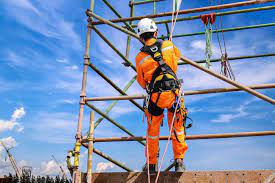
Constructing high-rise structures demands as much caution as expertise.
Whether your employees undergo working at heights training or just started at your construction sites, keeping safety tips in mind can save lives. An innocent slip of even a few meters can prove fatal. After all, this high-risk activity is one of the leading causes of death in building projects.
As an employer, it’s your duty to provide a safe working environment to your employees. Ensuring safety in projects with work at heights is one of the primary responsibilities you must take seriously.
How can you reduce the risk with construction at heights?
Generally, if a worker is engaged in a constructional activity at an elevation of 4 feet or above, it’s considered ‘working at height’. Now, the onus falls on you to ensure protection for your employees in such cases. Here’s how you can do it!
1. Erect railings
The steel rods aligned along the edges of the construction site are one of the most effective passive protection tactics. You don’t even need to train your workers to stay inside the circumference of rails. On top of this, there are various styles for you to choose from according to the construction structure.
2. Pick the right Fall-Arrest System.
Choosing a sturdy personal Fall Arrest System will ensure the safety of your workers and provide comfort in gear. There are many options for you to select based on the functionality your site demands.
So, if the work requires ample hanging around, some extra D-rings on your PFAS will be the right choice.
3. Check your protective gear.
You should not wait for the workers to wear the harness system at the job site to find out its efficiency. Ensure that you inspect the lanyards and rings using weight before offering them to your employees. It’ll not only stop preventable harm but also help you gauge the quality of your purchase.
4. Inspect your anchor points.
Your PPE kit with a strong harness is as good as the anchor holding it. That’s why it’s mandatory for you to get the point constructed by an experienced engineer. Moreover, you will also need to check for the load it can handle.
The higher the weight tolerance, the better the anchor point.
5. Use suitable equipment.
Take it out of your mind if you thought a single piece of construction equipment would be feasible for all the activities. Like the harness, your elevation tools must also be according to the project. For instance, a mobile scaffold will be good for roof painting but not multistorey construction.
6. Utilise the ladders properly.
For vertical movement at a construction site, a ladder is a right tool. However, most of the workers neglect its usage and this poses a threat to their lives. For this reason, it’s essential that you strictly train your workers to use the device for their interest and well-being.
In a nutshell.
Constructing safely at a height requires proper precautions and training. Taking shortcuts can not only cost a life but also bring the entire project to a halt.
That’s why working at heights training must be coupled with a supply of essential protective gear and cautionary practices. Not only will you be mitigating fall hazards but also saving money by enabling the projection completion without any unnecessary pauses due to accidents.